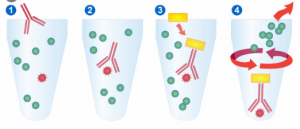Troubleshooting In Immunoprecipitation (Ip)
The Immunoprecipitation (IP) technique is an immunoassay commonly used to study proteins in solution, by using antibodies with high affinity for them.
In this post we bring you a short guide with tips for solving problems in Immunoprecipitation (IP) based on the most common causes. But first, let’s review what are the key factors in an Immunoprecipitation (IP) assay.
Key Factors In Immunoprecipitation (Ip)
- SAMPLE : the correct preparation of the sample is one of the key factors for the success of the immunoassay. When obtaining the antigen from cells or tissues, a suitable lysing buffer must be used that includes protease inhibitors (to avoid degradation of the antigens), as well as a descaling agent (to ensure that the cells release the antigen of interest).
- ANTIBODIES : one of the fundamental characteristics to look for in antibodies when carrying out any type of immunoassay is specificity. In immunoprecipitation, in addition, the affinity of the antibodies becomes another of the key factors. We remind you of this entry where you can see the advantages and disadvantages of using monoclonal or polyclonal antibodies depending on the type of immunoassay.
- BEADS OR MICROSPHERES : to induce immunoprecipitation, antibodies must bind to a solid substrate in the form of beads or microspheres. These can be agarose or magnetic, and the choice will depend on the individual needs of each assay. To mention some of the advantages maxanim, it is worth noting the high coupling capacity of the agarose microspheres, while the magnetic beads stand out for their great capacity for binding to large proteins.
Troubleshooting In Immunoprecipitation (Ip)
The most frequent problems in Immunoprecipitation assays usually translate into one of the following aspects: high background noise or inability to detect the target protein.
Below we detail the possible causes (PC) as well as the tips or solutions (S) to solve them:
1.- High Background Noise
PC: Incomplete wash
- S: Wash well after each step, covering the tube and inverting it several times before centrifuging.
PC: Binding of non-specific proteins to beads
- S1: Make sure that the beads have been correctly blocked with BSA.
- S2: Load a smaller amount of sample on the beads.
PC: Antibodies are not specific enough
- S: Use affinity purified antibodies against the antigen.
PC: Excess antibody that leads to non-specific binding
- S1: Review the recommended antibody concentration in the technical sheet.
- S2: Try to use a smaller amount of antibody.
PC: Antigen degradation during immunoprecipitation
- S: Make sure that protease inhibitors have been added to the lysate buffer.
PC: Proteins are not soluble in detergent
- S: Remove the supernatant immediately after centrifugation.
PC: Formation of protein aggregates
- S: Centrifuge to remove aggregates.
PC: Incubation time too long
- S: Reduce incubation times.
2.- Problems Detecting The Target Protein
PC: Target protein is not present in the sample
- S1: Check the expression profile of the target protein to ensure that it will be expressed in the cells of the sample.
- S2: Prepare fresh lysates (avoid using frozen lysates).
- S3: Use protease inhibitors in the lysate buffer.
PC: Target protein is present in very low concentration
- S: Increase the amount of lysate used, taking into account that this can result in an increase in non-specific unions.
PC: insufficient amount of antibody
- S1: Check that the antibody concentration recommended in the technical sheet is being used.
- S2: Increase the concentration of antibody.
PC: Antibody has not bound to beads
- S: Make sure that the appropriate beads are being used based on the isotype of the antibody used.
PC: Inadequate lysing buffer
- S: Check in the antibody technical sheet if it recognizes the native or denatured antigen, and adapt the lysate buffer.
PC: Washes too severe
- S1: Reduce the number of washes.
- S2: Reduce the concentration of salts and detergents in the wash buffer.
PC: The antibody does not have sufficient affinity for the antigen
- S: If the antibody binds weakly to the antigen, it is difficult for this binding to be maintained during the incubation and washing steps. In order to increase affinity, the use of polyclonal antibodies is recommended.
PC: Proteins cannot be eluted from beads
- S: Change the elution buffer according to its components, salinity, concentration, pH, etc.
PC: Excess of non-specific proteins in the sample that compete with the target antigen
- S: Centrifuge the sample to remove insoluble proteins and membrane fragments before adding the antibodies.
